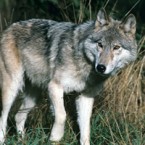During a House hearing on wolf conservation, Rep. Debbie Dingell claimed “the science is clear” that red wolves are not “hybrids” between coyotes and gray wolves. But the science is not clear — and the latest research has tipped the balance of evidence in favor of the hybrid hypothesis.
If recognized as a hybrid, the red wolf could risk losing protection under the Endangered Species Act — an outcome hunters, landowners and ranchers advocate, in part, because red wolves and other wolf species prey on livestock and deer. The new research may also influence the status of other wolf species under the act, such as the gray wolf and the eastern wolf.
 In order to be eligible for federal protection under the act, a plant or animal must be classified as a distinct species, including “any subspecies of fish or wildlife or plants, and any distinct population segment of any species of vertebrate fish or wildlife which interbreeds when mature.” However, the act lacks specific provisions for hybrids between endangered and unlisted species — making it unclear if the red wolf should continue to be protected.
In order to be eligible for federal protection under the act, a plant or animal must be classified as a distinct species, including “any subspecies of fish or wildlife or plants, and any distinct population segment of any species of vertebrate fish or wildlife which interbreeds when mature.” However, the act lacks specific provisions for hybrids between endangered and unlisted species — making it unclear if the red wolf should continue to be protected.
At present, the red wolf is classified as a distinct species and protected under the act. The gray wolf is also classified as a distinct species and protected, but the coyote and eastern wolf, also distinct species, aren’t protected.
Scientists, legal scholars and government officials have debated the standing of hybrids under the act since shortly after its passage in 1973. Members of Congress continued that debate during a Sept. 21 House Natural Resources Committee hearing on the “Status of the Federal Government’s Management of Wolves.”
In an effort to quell the debate and advocate red wolf protection, Dingell, a Democrat from Michigan, offered what she called “a few facts” in her opening statement. For example, she said, the “science is clear” that gray wolves, Mexican wolves and red wolves “are not foreign imports or hybrids.” The science is relatively clear on gray wolves and Mexican wolves (a subspecies of gray wolf), but not on red wolves.
Dingell repeated her claim later in the hearing while questioning a witness, John Vucetich, a population biologist at Michigan Technological University. She said, “The red wolf is not a coyote hybrid, even though the two animals share common ancestry.”
Despite Dingell’s claims, both the ancestry of and conservation policies for red wolves remain unsettled. In the next section, we’ll provide some context regarding how the unclear ancestry of the red wolf affects its protection under the Endangered Species Act. We’ll also explain why the latest research — a study published in the journal Science Advances on July 27 — still doesn’t conclusively settle the hybrid debate.
Classification Complicates Conservation
In 1996, the U.S. Fish and Wildlife Service and the National Marine Fisheries Service drafted a policy that outlined rules for deciding when hybrids should and shouldn’t be protected under the Endangered Species Act based on available research at the time. But there was disagreement over whether the policy was sufficient as written. To this day, the FWS and NMFS have neither formally adopted nor rejected that policy. As a result, the act still remains unclear on its protection of hybrids.

Meanwhile, researchers have continued to debate the family tree of North America’s wolf species and their closest relatives. As Charles Darwin himself hypothesized, different species can result from adaptation to specific environments, which gives an organism a distinct evolutionary lineage.
But sometimes distinct species interbreed, producing sterile or nonsterile hybrids. Mules, for example, are the sterile offspring of horses and donkeys. Among other animals, a number of wolf species and coyotes also interbreed, but can produce nonsterile offspring. These offspring then go on to breed with other wolves and coyotes – even with dogs in some cases.
Some scientists, such as the authors of the Science Advances paper, support the theory that there are only two distinct “wolf-like” species on the continent, the gray wolf and the coyote. Under this hypothesis, the red and eastern wolves are hybrids, the result of generations of interbreeding between gray wolves and coyotes.
Other researchers argue there are three species with distinct evolutionary lineages – the gray wolf, the eastern wolf and the coyote. Under this theory, the red wolf is considered a distinct population of, but the same species as, the eastern wolf.

And still others argue that there is a fourth species with its own separate lineage – the red wolf. These researchers claim red wolves have only recently undergone hybridization with coyotes in the wild, but that “pure” red wolves still exist in captivity.
In 1973, the FWS designated the red wolf an endangered species under the act and shortly thereafter began a captive breeding program with what it deemed 14 “pure” red wolves. The red wolf was extinct in the wild in 1980. In 1987, the FWS began reintroducing its captive red wolves into the wild in northeastern North Carolina. The number of wild red wolves currently tops 45 to 60, according to the FWS.
When red wolf reintroduction into the wild began, coyotes didn’t inhabit northeastern North Carolina. Today coyotes do roam these areas, putting these supposedly “pure” red wolves at risk for hybridization, says the FWS.
But as we’ve already explained, the latest research on wolf genetics suggests that red wolves weren’t a distinct species to begin with, but hybrids between gray wolves and coyotes. However, the authors of the Science Advances paper do offer a potential solution to the confusion their research may present for conservation practices.
To Be or Not to Be a Hybrid
Despite Dingell’s claim, the most recent research provides evidence to support the theory that both red wolves and eastern wolves are hybrids, not distinct species. In fact, Robert Wayne, an author on the Science Advances study and an evolutionary biologist at the University of California, Los Angeles, told us by email, “our paper did suggest both species were hybrids of gray wolf and coyote.”
Just two years ago, more research countered the hybrid hypothesis. A November 2014 report produced for the FWS by the Wildlife Management Institute on red wolf recovery efforts, stated: “Recent genetic data have cast doubt upon the hybrid origin hypothesis and the balance of evidence has tilted towards a North American canid assemblage composed of the eastern wolf, the red wolf, and the coyote as distinct” species. Though the authors add, “The hybrid origin hypothesis has not been conclusively refuted.”
However, previous studies had looked at “a limited fraction of the genome” of different wolf-like species, explain Wayne and his colleagues in their paper. In contrast, Wayne’s group analyzed the complete genomes of different wolf and coyote individuals, which gave the researchers a better ability to compare the hypothesis of “unique ancestry as opposed to hybrid origin.”

Using this method, Wayne and his group found that both eastern and red wolves shared a great number of genes with gray wolves and coyotes — more than would be expected if they were distinct species with their own evolutionary lineages. In other words, red and eastern wolves had very few “novel” genes not found in either gray wolves or coyotes. In fact, red wolves had a higher proportion of coyote genes compared with gray wolf genes, the researchers concluded. Eastern wolves, on the other hand, had a higher proportion of gray wolf than coyote genes.
The proportions of coyote versus gray wolf genes found in red and eastern wolves, the authors argue, parallel the patterns of “European colonization and the conversion of woodland habitat to agricultural landscape” beginning in the late 1800s. This process began in the southeast U.S., where red wolves now live, only later reaching the Great Lakes region, the territory of eastern wolves, in the early 1900s, they explain.

In other words, earlier stresses from human colonization could have resulted in decreases in gray wolf populations in the southeast U.S. and thus more hybridization between wolves and coyotes in this region. As a result, humans themselves may have heavily influenced the “south-to-north gradient” in proportions of gray wolf versus coyote genes seen in red wolves and eastern wolves.
Still, some wolf experts, such as Linda Y. Rutledge at Princeton University, argue that Wayne’s study doesn’t conclusively settle the debate, reported the New York Times. Some of the samples his group used may have been collected from wolves that are contemporary hybrids, as interbreeding between eastern wolves and coyotes and red wolves and coyotes has also occurred more recently.
Wayne also told us by email, “This does not mean that [red wolves] should not be protected.” Why? In his paper, he and his co-authors argue the “overly strict application” of classification to “support endangered species status is antiquated” because it’s often difficult to apply theoretical concepts like “species” and “subspecies” in practice.
What’s more important, the group argued, is the “preservation of evolutionary and ecological processes and the role of an endangered [species] in this dynamic.” In fact, hybridization “is one critical example of a process that may enhance adaptation and evolution in the rapidly changing environment of the modern world,” they add. Thus, eastern and red wolves shouldn’t be excluded from protection under the Endangered Species Act solely because they’re hybrids, the authors conclude.
While questioning Vucetich, the population biologist at Michigan Tech, Dingell also said that experts agree “the red wolf is a listable entity under the Endangered Species Act under any plausible scenario describing its evolutionary history.” This is accurate, but requires some context.
For example, a Sept. 6 report regarding the FWS’ Red Wolf Recovery Program summarized, among other things, the outcome of a U.S. Geological Survey workshop on red wolf classification and conservation, which took place in Atlanta between May 24 and 26: “Scientists and legal scholars attending the USGS workshop agreed that the red wolf is a listable entity [under the Act]; though they did not reach consensus on whether it is a full species, subspecies or a distinct population segment. But the report authors added, “This consensus must be considered tentative pending publication of their findings.”
Members of a different group — the red wolf recovery team — however, couldn’t reach agreement on whether the red wolf is a listable entity, the report states. This is due, in part, to the fact that, in addition to scientists, that team includes landowners who opposed red wolf recovery efforts because they believe the FWS has illegally released red wolves onto private land.
It’s also important to note that, while experts at the USGS workshop agreed tentatively that the red wolf is a “listable entity” under the act, this doesn’t necessarily mean the red wolf will actually remain protected. The Sept. 6 report noted that a culmination of reasons might lead the FWS to swing one way or the other on this decision, including whether or not continuing to protect red wolves in the wild and captivity will be “feasible” in practice.
So Dingell wasn’t completely off the mark on the scientific agreement over whether the red wolf is a “listable entity” under the act. However, she did stretch the truth when she said “the science is clear” that red wolves are not “hybrids” between coyotes and gray wolves. The science is not clear, and the latest research suggests both red and eastern wolves are hybrids. Thus, the classification, and potentially the conservation, of red wolves, still hangs in the balance.
Editor’s Note: SciCheck is made possible by a grant from the Stanton Foundation.